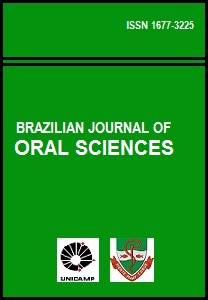Abstract
Aim: To evaluate the influence of construction bite in the dentoskeletal changes induced by Klammt Appliance. Methods: The sample consisted of 17 children, with Class II malocclusion and initial mean age of 8.5 years. The construction bite was obtained using an Exactobite on edge-toedge anteroposterior relationship with 3 mm interincisal clearance. The height of the acrylic was determined by initial overbite associated to interincisal clearance and measured with digital caliper. The amount of advancement was obtained and measured by initial overjet in the lateral radiography. Pearson’s correlation, linear regression and ANOVA were used to determine the relationship between dentoskeletal and construction bite variables. Results: The increase in the height of the acrylic promotes a greater inhibition of the forward displacement of the nasal spine and reduction in the facial growth index. The increase in the mandibular advancement induces more downward displacement of nasal spine and pogonion; a counter-clockwise rotation of palatine plane; an increase in mandibular length, maxillary alveolar height and interincisal angle; a decrease in mandibular alveolar height, the intermaxillary discrepancy and overjet; and palatal tipping of upper incisors. Conclusions: The different dimensions of the construction bite influence the dentoskeletal changes induced by the appliance in Class II treatment.The Brazilian Journal of Oral Sciences uses the Creative Commons license (CC), thus preserving the integrity of the articles in an open access environment.
Downloads
Download data is not yet available.

